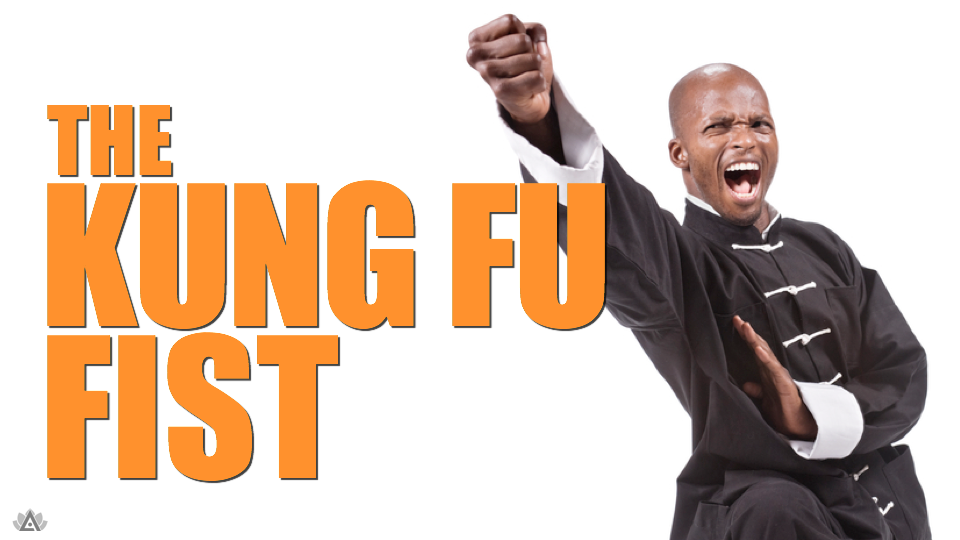
The Kung Fu Fist
The Kung Fu Fist is somewhat unique among martial arts and combat sports for a number of different reasons, including its emphasis on safe structural alignment, power generation, and concept or strategy of striking.
In the Chinese martial art of Wing Chun it is called "Yut" Jee or Sun Character Fist. The name comes as a reference to the written Chinese ideogram for "sun," which resembles a box with a bisecting horizontal line. The line represents the lines between the fingers when the hand is tightened into a fist. The fingers are stacked horizontally, with the knuckles oriented up and down vertically. This fist structure is the root of all strikes in Wing Chun, and is often simply called the "vertical fist."
Before we go further, let's reiterate an important point: the hand is NOT a good impact weapon. Good impact weapons are solid: a baseball bat, a rock, a brick, etc. The human hand is designed for fine movement and flexible articulation, making it a good choice for grasping and manipulation. Anatomically it is a matrix of small muscles supported by a lot of tiny bones and infused with a massive number of very sensitive nerves. The hand is NOT a hammer, but it is really good at HOLDING a hammer.
In the absence of hammers, baseball bats, rocks and bricks, however, sometimes we are forced to hit with our hands. When we do, we should be careful not to break them.
Boxers do not wear 16 ounce padded gloves so that they don't hurt their opponents. They wrap and glove their hands so they don't snap the carpal and metacarpal bones in what is called a "boxer's fracture." A punch from a trained boxer or martial artist can deliver a massive amount of kinetic energy into the target, but the impact can also reflect a lot of that power back into the fist. We want to reduce the potential for injury by transmitting that kinetic force into larger, more resilient tissue.
STRUCTURE: The SAFE Way to Hit
The most important aspect is structure. The fist is formed by rolling the fingers tightly into the palm and then braced by the side of the thumb. You want the fist to be structurally tight with no space and no slack. This will allow impact force to transmit through the hand and into the arm instead of bouncing around where it can do damage.
Packed tightly, you should not need excessive muscle tension to hold the fist together. Gripping your fist too tightly will radiate the tension into your forearm, recruiting other muscles to the effort. You do not want this, as tight, tense muscles are slow muscles. You want to pack the fist tightly and use just enough tension to keep it pulled taut, allowing you to keep the rest of the arm muscles relaxed.
The striking surface of the fist is the bottom three knuckles. This lines up the maximum number of carpal bones in the back of the hand perpendicular to the impact surface. This again minimizes the potential for damage to the bones of the hand.
Note that some martial arts emphasize striking with the top two knuckles, or even advise "snapping" the wrist into the target. This is a great way to meet your local radiologist. While x-ray technicians are renowned for their attractiveness, your primary goal should be to keep the fist tight and keep the bones aligned so that the force of impact transmits through the hand, through the wrist, and is distributed through the larger muscles of the forearm and the structural support of the ulna and radius bones.
The vertical alignment – at roughly shoulder height – almost perfectly aligns the bones of the hand with the bones of the forearm, thereby providing the highest degree of stability. As the fist strikes higher targets, it will supinate or rotate to an angle with the palm turning upwards. As the fist strikes at lower targets, it will pronate or rotate at an angle with the palm turning towards the ground.
The other important structural point about the vertical fist is that positions the elbow in and down. This positions the striking arm directly in front of the chest along the centerline. This allows any rebound force from the strike to be channeled through the arm and into the stance. In contrast, the rebound of a horizontal, elbow-out punch will travel to the outside of the central axis of rotation, creating torque in the striker's body which may compromise balance.
Oh, No!
You have reached a page – or a portion of a page – that is not currently available for public viewing. That's one of the drawbacks of accessing this preview edition. If you have a Preview Code, please enter it into the form below. Otherwise, please check back at a later time, as we are continually activating additional content all the time.
